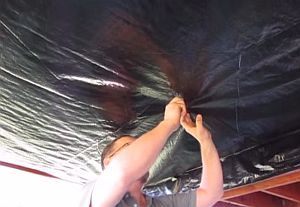 A mobile home vapor barrier is an essential component of the underbelly of a mobile or manufactured home. It acts as a protective layer against moisture, preventing it from seeping into the structure and causing damage. Over time, however, vapor barriers may deteriorate due to wear and tear, environmental factors, or improper installation. This article aims to provide insights into the lifespan of a mobile home vapor barrier and when it may need replacement. By understanding the signs of deterioration and following a proactive maintenance approach, homeowners can ensure the longevity and structural integrity of their mobile homes.
A mobile home vapor barrier is an essential component of the underbelly of a mobile or manufactured home. It acts as a protective layer against moisture, preventing it from seeping into the structure and causing damage. Over time, however, vapor barriers may deteriorate due to wear and tear, environmental factors, or improper installation. This article aims to provide insights into the lifespan of a mobile home vapor barrier and when it may need replacement. By understanding the signs of deterioration and following a proactive maintenance approach, homeowners can ensure the longevity and structural integrity of their mobile homes.
- Understanding Mobile Home Vapor Barriers: A mobile home vapor barrier, also known as a moisture barrier or underbelly barrier, is a plastic or foil sheet that is installed beneath the mobile home. It serves as a protective barrier against moisture and condensation that can occur due to temperature variations, humidity, or moisture in the ground. The primary purpose of a vapor barrier is to prevent moisture from entering the subfloor, insulation, and other components of the mobile home. By reducing moisture levels, it helps prevent issues like wood rot, mold growth, and structural damage. A well-installed and maintained vapor barrier can significantly extend the lifespan of a mobile home.
Mobile Home Vapor Barrier lifespan factors:
Several factors can influence the lifespan of a mobile home vapor barrier. Understanding these factors can help homeowners determine when replacement may be necessary. Some of the key factors include:
a) Material Quality: The quality of the vapor barrier material plays a significant role in its durability. High-quality materials are less likely to deteriorate quickly, offering better protection against moisture intrusion.
b) Installation Quality: Proper installation is crucial for the effectiveness and longevity of a vapor barrier. A poorly installed barrier may develop gaps, tears, or sagging, which can lead to moisture penetration and subsequent damage.
c) Environmental Conditions: The local climate, temperature variations, and humidity levels can impact the lifespan of a vapor barrier. Regions with high humidity, extreme temperatures, or frequent weather fluctuations may experience more wear and tear on the barrier.
d) Ground Moisture: The moisture content in the ground beneath the mobile home can affect the vapor barrier. If the ground has excessive moisture or poor drainage, it can exert pressure on the barrier, leading to deterioration.
e) Maintenance and Inspection: Regular maintenance and inspection are crucial for identifying early signs of deterioration or damage. Timely repairs or replacements can prevent further issues and extend the lifespan of the vapor barrier.
Signs of Deterioration: Identifying the signs of vapor barrier deterioration is essential for determining when replacement is necessary. Here are some common indicators that a mobile home vapor barrier may need replacement:
a) Tears or Rips: Visible tears or rips in the vapor barrier allow moisture to enter, reducing its effectiveness. These can occur due to age, impact, or animal damage.
b) Sagging or Wrinkling: A sagging or wrinkled vapor barrier indicates that it has lost its structural integrity and may not be providing adequate protection against moisture intrusion.
c) Mold or Mildew Growth: If mold or mildew is present on the vapor barrier, it suggests that moisture has penetrated and created a favorable environment for microbial growth.
d) Foul Odors or Musty Smells: Dampness and moisture trapped within the mobile home can cause unpleasant odors, indicating a compromised vapor barrier.
e) Increased Energy Costs: A deteriorating vapor barrier may lead to higher heating or cooling bills. Escaping air or moisture infiltration can force HVAC systems to work harder, resulting in increased energy consumption.
Replacement Recommendations: While there is no fixed timeline for replacing a mobile home vapor barrier, considering the aforementioned factors and signs of deterioration can guide homeowners in determining when replacement is necessary. Generally, vapor barriers should be inspected at least once a year, preferably during routine maintenance checks.
If the vapor barrier shows signs of damage or deterioration, it is advisable to replace it promptly. Waiting too long can result in further damage to the subfloor, insulation, or other structural components, leading to more extensive repairs and costs. Moreover, if the mobile home is relocated, it is recommended to assess the condition of the vapor barrier during the moving process. Transportation and handling can cause damage to the barrier, requiring replacement or repairs before reinstallation.
A mobile home vapor barrier is a critical element in protecting against moisture intrusion and maintaining the structural integrity of the home. While there is no fixed timeline for replacement, factors such as material quality, installation, environmental conditions, and regular maintenance play significant roles in determining when a replacement is needed.
Homeowners should proactively inspect their vapor barriers for signs of damage, such as tears, sagging, mold growth, or foul odors. Timely replacement or repairs can prevent more extensive issues and ensure the long-term durability of the mobile home.
Consulting with professionals experienced in mobile home maintenance and repair can provide further guidance on the specific needs of the vapor barrier and help homeowners make informed decisions regarding replacement or maintenance. By prioritizing the health of the vapor barrier, homeowners can safeguard their mobile homes from moisture-related problems and extend their lifespan.